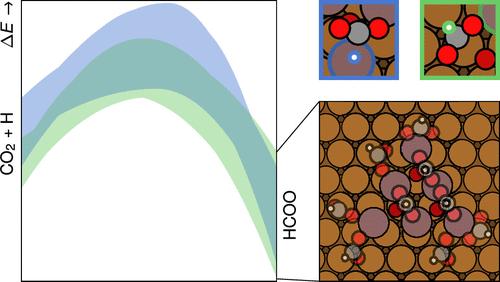用反催化剂打破结垢关系:co2 -甲酸能垒趋势的机器学习探索
IF 13.1
1区 化学
Q1 CHEMISTRY, PHYSICAL
引用次数: 0
摘要
将二氧化碳转化为有用的产品,如甲醇,是减少气候变化和我们对化石燃料依赖的关键战略。为这一过程开发改进的催化剂既昂贵又耗时,因此可以从计算探索可能的活性位点中获益。然而,由于材料和反应网络的复杂性,这是复杂的。在这里,我们提出了一种基于神经网络的机器学习原子间势训练的工作流程,用于探索逆催化剂基本反应步骤的过渡态。我们重点研究了关键的甲酸中间体及其在Cu支撑的氧化铟纳米团簇上的形成(111)。与纯粹基于密度泛函理论的方法相比,这种加速使我们能够探测在不同尺寸和化学计量的纳米簇上发现的各种活性位点。对所获得的过渡态几何图形的分析揭示了纳米团簇边缘和内部不同的结构活性趋势。此外,所确定的几何形状允许打破线性缩放关系,这可能是实验中观察到的反相催化剂催化性能的关键潜在原因。本文章由计算机程序翻译,如有差异,请以英文原文为准。

Breaking Scaling Relations with Inverse Catalysts: A Machine Learning Exploration of Trends in CO2-to-Formate Energy Barriers
The conversion of CO2 into useful products such as methanol is a key strategy for abating climate change and our dependence on fossil fuels. Developing improved catalysts for this process is costly and time-consuming and can thus benefit from computational exploration of possible active sites. However, this is complicated by the complexity of the materials and reaction networks. Here, we present a workflow for exploring transition states of elementary reaction steps at inverse catalysts, which is based on the training of a neural network-based machine learning interatomic potential. We focus on the crucial formate intermediate and its formation over nanoclusters of indium oxide supported on Cu(111). The speedup compared to an approach purely based on density functional theory allows us to probe a wide variety of active sites found at nanoclusters of different sizes and stoichiometries. Analysis of the obtained set of transition state geometries reveals different structure–activity trends at the edge or interior of the nanoclusters. Furthermore, the identified geometries allow for the breaking of linear scaling relations, which could be a key underlying reason for the catalytic performance of inverse catalysts observed in experiments.
求助全文
通过发布文献求助,成功后即可免费获取论文全文。
去求助
来源期刊

ACS Catalysis
CHEMISTRY, PHYSICAL-
CiteScore
20.80
自引率
6.20%
发文量
1253
审稿时长
1.5 months
期刊介绍:
ACS Catalysis is an esteemed journal that publishes original research in the fields of heterogeneous catalysis, molecular catalysis, and biocatalysis. It offers broad coverage across diverse areas such as life sciences, organometallics and synthesis, photochemistry and electrochemistry, drug discovery and synthesis, materials science, environmental protection, polymer discovery and synthesis, and energy and fuels.
The scope of the journal is to showcase innovative work in various aspects of catalysis. This includes new reactions and novel synthetic approaches utilizing known catalysts, the discovery or modification of new catalysts, elucidation of catalytic mechanisms through cutting-edge investigations, practical enhancements of existing processes, as well as conceptual advances in the field. Contributions to ACS Catalysis can encompass both experimental and theoretical research focused on catalytic molecules, macromolecules, and materials that exhibit catalytic turnover.
 求助内容:
求助内容: 应助结果提醒方式:
应助结果提醒方式:


